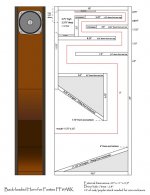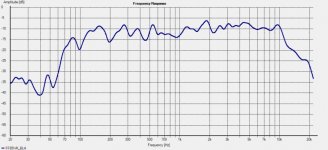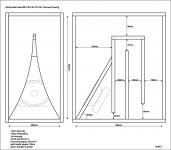Besides chamber and throat, this will have some effect: Cutoff fs x 2 / Qts, 418 Hz for the FF85 if Madisound TSP are correct. I hope the topic starter can help us out, very curious what he found and tried.
Hello again, I'm new at this what is Hornresp... and how can I get it so I can get the dimensions for the FF85WK BLH.... DAN
Hi Dan,
Hornresp is a free program to simulate horns. Do a google and you will find a download. Sadly all the effort is going to the program and not into the user manual so it's quite a steep curve to master Hornressp...
Hornresp is a free program to simulate horns. Do a google and you will find a download. Sadly all the effort is going to the program and not into the user manual so it's quite a steep curve to master Hornressp...
Phenoholic, is there any suggestions where i can find a already proven design for the ff85wk using the blh.. dan
Dan, let's wait for the Topic starter, he seems to have designed a good horn for this little driver. I have no personal experience with this driver. Only know the FE103.
Hi xrk971, do you mean that a smaller throat implies that the upper cutoff will be lower? Sorry to be dense (it seems reasonable now that you say it, I just never thought of that before you said it).
Yes, the cutoff freq is given by fc=(c So)/(2 pi V) where c is speed of sound, So is throat area, and V is chamber volume. So as So gets smaller or as V gets bigger, the freq goes lower.
There is a lot more useful info and theory on the design of BLH's in MJK's website. He has written a bunch of excellent whitepapers on horn design. Check it out: Horn Theory
Using this simple relation and many of the other equations that you can find in the papers in the above link, you can set the length of the horn, and the flare (or expansion) rate which sets the lower cutoff freq for horn gain of the bass octaves. You will see that it all comes down to a design of compromises as an ideal horn will be huge and not manageable to build or fit in a room.
Once these basic equations are used to set a rough size for a design, the next step is to put the design into a model like MJK worksheets or AkAbak - then you can fine tune the design to match the driver's TS params and your design goals. I can post a basic BLH AkAbak script for anyone interested. If IG81 posts his dimensions it would be pretty easy to model it in AkAbak. Most BLH speakers will have peaks and resonances. They will have good bass gain compares to a MLTL but will not be as flat in reaponse, typically. They will tend to have some mid coloration but that is not necessarily a bad thing for some kinds of music like jazz and vocals.
Last edited:
Hi xrk971,
Many thanks for the formula as well as the link. I would definitely be interested in a basic AkAbak BLH script, if you were to post it. That sounds really cool.
Many thanks for the formula as well as the link. I would definitely be interested in a basic AkAbak BLH script, if you were to post it. That sounds really cool.
Besides chamber and throat, this will have some effect: Cutoff fs x 2 / Qts, 418 Hz for the FF85 if Madisound TSP are correct. I hope the topic starter can help us out, very curious what he found and tried.
Phenoholic, is there any suggestions where i can find a already proven design for the ff85wk using the blh.. dan
Dan, let's wait for the Topic starter, he seems to have designed a good horn for this little driver. I have no personal experience with this driver. Only know the FE103.
I took a small break from the forum and missed these replies.
Strange how I've received a bunch of PM's and requests for a plan for this little "horn" despite never having outright recommended it. It was no more than a simple design I had in mind, where I planned to test a Hornresp simulation using a fairly simple material and build implementation.
It sounded alright, but I'm sure there are much better solutions for FF85WK out there. That being said, I don't have these enclosures anymore (for maybe a good 6 months) and don't remember the exact throat setup I ended up with. Here are the images for the plan and response I could rescue from my old Imageshack account - not very big unfortunately.


The "horn" part worked well enough to negate baffle-step; these could be out in the center of the room and sounded balanced. Driver Qt is higher than typical horn specs, but the Fs being high as well allowed for a high mass-corner to use horn-loading underneath. The horn mouth could/should have been larger IMO. It had usable bass into the 70Hz range I'd say.
The horn output could have been cleaner and 'boisterous' is the best word I can use to describe what I perceived. This added some weight and punch to certain source material - but was detrimental on other stuff, much like I found my various Karlsons to be. Single acoustic instruments, voice, girls&guiar, jazz trios, chamber music and electronica all sounded pretty good. The heavier rock genres fared poorly OTOH.
I have a design for a Nagaoka F81 inspired box that sounded cleaner when I built a foamcore prototype. I may yet get around to building this.
The horn output could have been cleaner and 'boisterous' is the best word I can use to describe what I perceived. This added some weight and punch to certain source material - but was detrimental on other stuff, much like I found my various Karlsons to be. Single acoustic instruments, voice, girls&guiar, jazz trios, chamber music and electronica all sounded pretty good. The heavier rock genres fared poorly OTOH.
I have a design for a Nagaoka F81 inspired box that sounded cleaner when I built a foamcore prototype. I may yet get around to building this.
The F81 might be a lot better for this driver. It's sort of a TL/horn hybrid, which seems to me more suited to the specs of the FF85. Actually more like an end loaded TL I think, and as such probably clever placement and choice of damping material will make a big difference.
FWIW, your builds with the experimental micro scaled Karlsons derived from the original K8 contributed toward the development of one that actually worked when small. It's important when developing something to find out what doesn't work. Karlsonators actually sound very nice with rock and all sorts of music. Now there's the XKi too, and other spawn...
The F81 might be a lot better for this driver. It's sort of a TL/horn hybrid, which seems to me more suited to the specs of the FF85. Actually more like an end loaded TL I think, and as such probably clever placement and choice of damping material will make a big difference.
FWIW, your builds with the experimental micro scaled Karlsons derived from the original K8 contributed toward the development of one that actually worked when small. It's important when developing something to find out what doesn't work. Karlsonators actually sound very nice with rock and all sorts of music. Now there's the XKi too, and other spawn...
A straight-up F-81 might indeed be good for F85WK. I proposed a slightly 'saner' and shorter version, but I'm re-thinking some of the over-simplifications. I should free-up an evening and buy a few foamcore sheets to see.
The K5's were hella kute and could play pretty loud, but not much else indeed. 🙂
This other 'crazy' idea predates the wave of modern mini-K's but is in the HAK spirit, as well as a spiritual successor to the older mini K-lines / K-TL.
'Karlsonized' BK10

I only ever foam-cored an actual BK-10, not bad in its own right.
- Status
- Not open for further replies.
- Home
- Loudspeakers
- Full Range
- Little DIY back-load horn for FF85WK